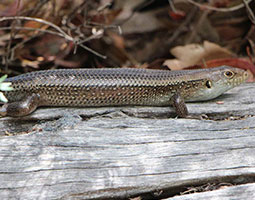Egernia frerei
Description

The Major Skink (Egernia frerei) is found along the east coast of Australia from Coffs Harbour to the tip of Cape York. Along its range this large, shy skink inhabits rocky outcrops in a variety of ecosystems including scrubland, rainforests and woodlands. Growing to 40cm in length and being very thickset, it is one of Australia’s largest skinks.
The colour of this lizard varies from nearly black, through various shades of brown to a light fawn colour.
The Major Skink is commonly confused with the closely related Land Mullet (Egernia major), which is also found in south east Queensland and northern New South Wales.
Adaptations
- Bask until they reach their preferred body temperature of 30 to 32°C
- Like many other lizards this species of skink will brumate very early in the season even when temperatures are still above 30°C
- Bask near to cover such as logs and rocks where they will quickly run when disturbed due to their shy nature
Feeding relationships
- What I eat: mainly insects, snails, spiders, smaller reptiles and various plant fruits
- What eats me: Lace monitors, kookaburras, snakes, feral cats and dogs
Interesting facts
Major skinks also have a highly developed social structure, and will pair for life with a single partner, producing from 3-6 live young each year. It is also not uncommon to see a group of 5 or 6 lizards basking together. Genetic testing has shown that these are typically family groups made of a number of generations. This is an incredibly interesting social structure that most other reptiles do not have.